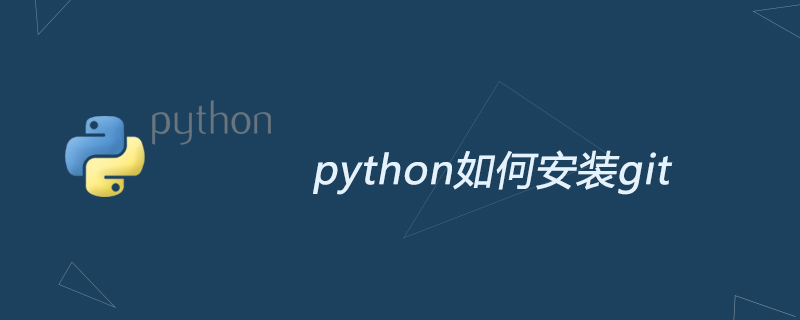Home >Backend Development >Python Tutorial >How to install git in python
How to install git in python
- 尚Original
- 2019-07-03 16:15:5513054browse

Installing Git
Before you start using Git, you need to install it on your computer. Even if it is already installed, it is best to upgrade it to the latest version. You can install it through a software package or other installation program, or download the source code, compile and install it.
Installation on Linux
If you want to install Git on Linux using a binary installer, you can install it using the basic package management tools included with the distribution. If you're on Fedora as an example, you can use yum:
$ sudo yum install git
If you're on a Debian-based distribution, try apt-get:
$ sudo apt-get install git
For more options, Git The official website has installation steps on various Unix-style systems at http://git-scm.com/download/linux.
Installation on Mac
There are many ways to install Git on Mac. The easiest way is to install the Xcode Command Line Tools. In systems with Mavericks (10.9) or higher, try running the git command for the first time in Terminal. If you have not installed the command line developer tools, you will be prompted to install them.
If you want to install a newer version, you can use the binary installer. The officially maintained OSX Git installer can be downloaded from the official Git website at http://git-scm.com/download/mac.
Installation on Windows
There are several installation methods for installing Git on Windows. The official version can be downloaded from the Git official website. Open http://git-scm.com/download/win and the download will start automatically. Please note that this is a project called Git for Windows (also called msysGit), which is a separate project from Git; for more information, please visit http://msysgit.github.io/.
Another easy way is to install GitHub for Windows. The installer includes both graphical and command-line versions of Git. It also supports Powershell, provides stable credential caching and robust CRLF settings. We'll know more about this later, but for now just one sentence is all you need. You can download it from the GitHub for Windows website at http://windows.github.com.
Installing from source code
Some people think that installing Git from source code is more practical because you can get the latest version. Binary installers tend to have some lag, but of course Git has matured in recent years and this difference is no longer significant.
If you want to install Git from source code, you need to install the libraries that Git depends on: curl, zlib, openssl, expat, and libiconv. If you have yum (such as Fedora) or apt-get (such as Debian-based systems) on your system, you can use one of the following commands to install the minimal dependency package to compile and install the binary version of Git:
$ sudo yum install curl-devel expat-devel gettext-devel \ openssl-devel zlib-devel $ sudo apt-get install libcurl4-gnutls-dev libexpat1-dev gettext \ libz-dev libssl-dev
In order to be able to add documents in more formats (such as doc, html, info), you need to install the following dependency packages:
$ sudo yum install asciidoc xmlto docbook2x $ sudo apt-get install asciidoc xmlto docbook2x
When you have installed all the necessary dependencies, you can continue from several places to obtain the latest released version of the tarball. You can get it from the Kernel.org website at https://www.kernel.org/pub/software/scm/git, or from the mirror on the GitHub website at https://github.com/git /git/releases. Usually the version on GitHub is the latest version, but kernel.org contains file download signatures, which you can use if you want to verify the correctness of the download.
Next, compile and install:
$ tar -zxf git-2.0.0.tar.gz $ cd git-2.0.0 $ make configure $ ./configure --prefix=/usr $ make all doc info $ sudo make install install-doc install-html install-info
After completion, you can use Git to get Git upgrades:
$ git clone git://git.kernel.org/pub/scm/git/git.git
For more Python related technical articles, please visit PythonTutorial column to learn!
The above is the detailed content of How to install git in python. For more information, please follow other related articles on the PHP Chinese website!

